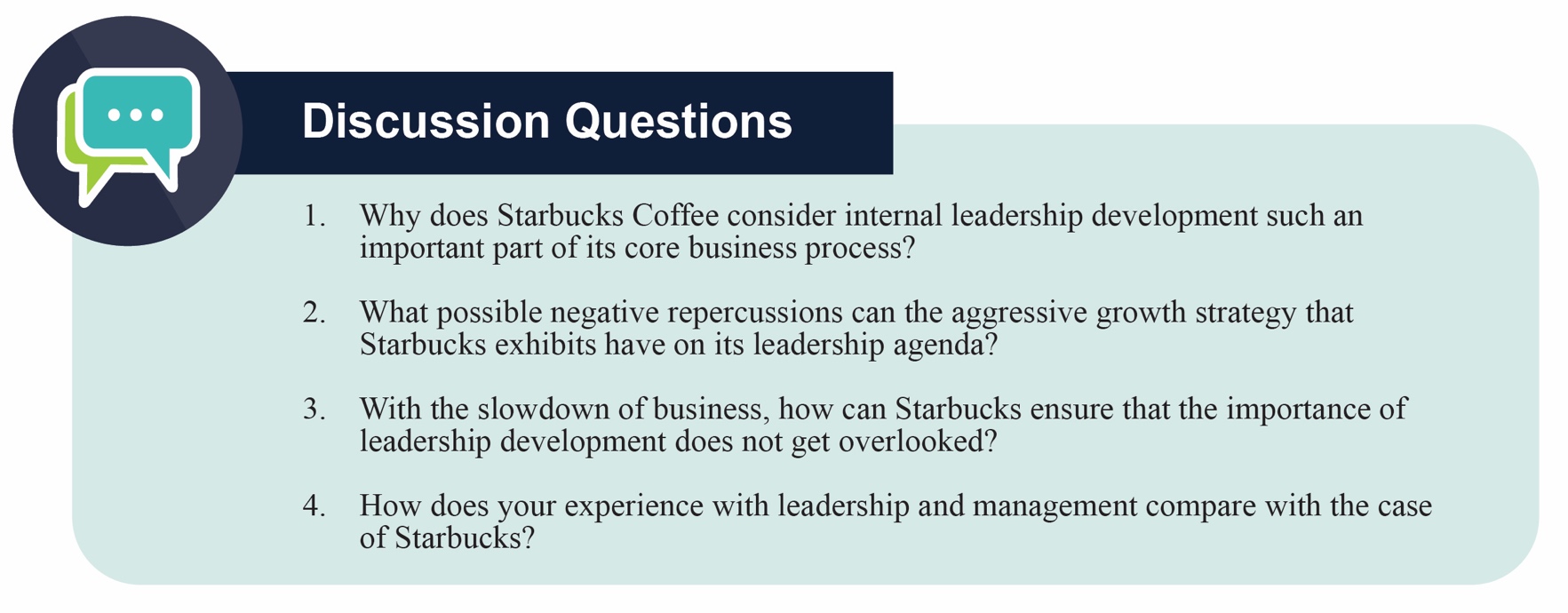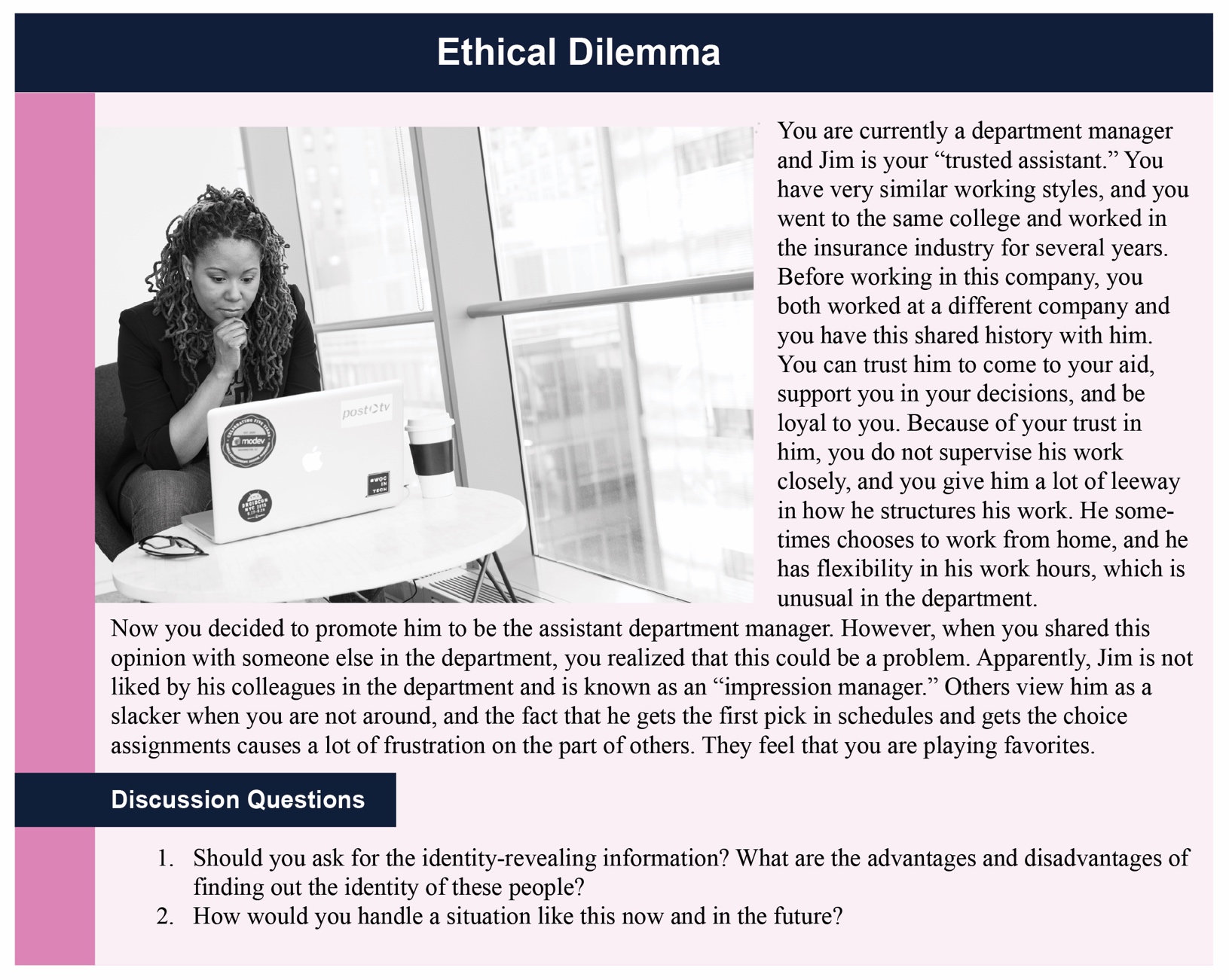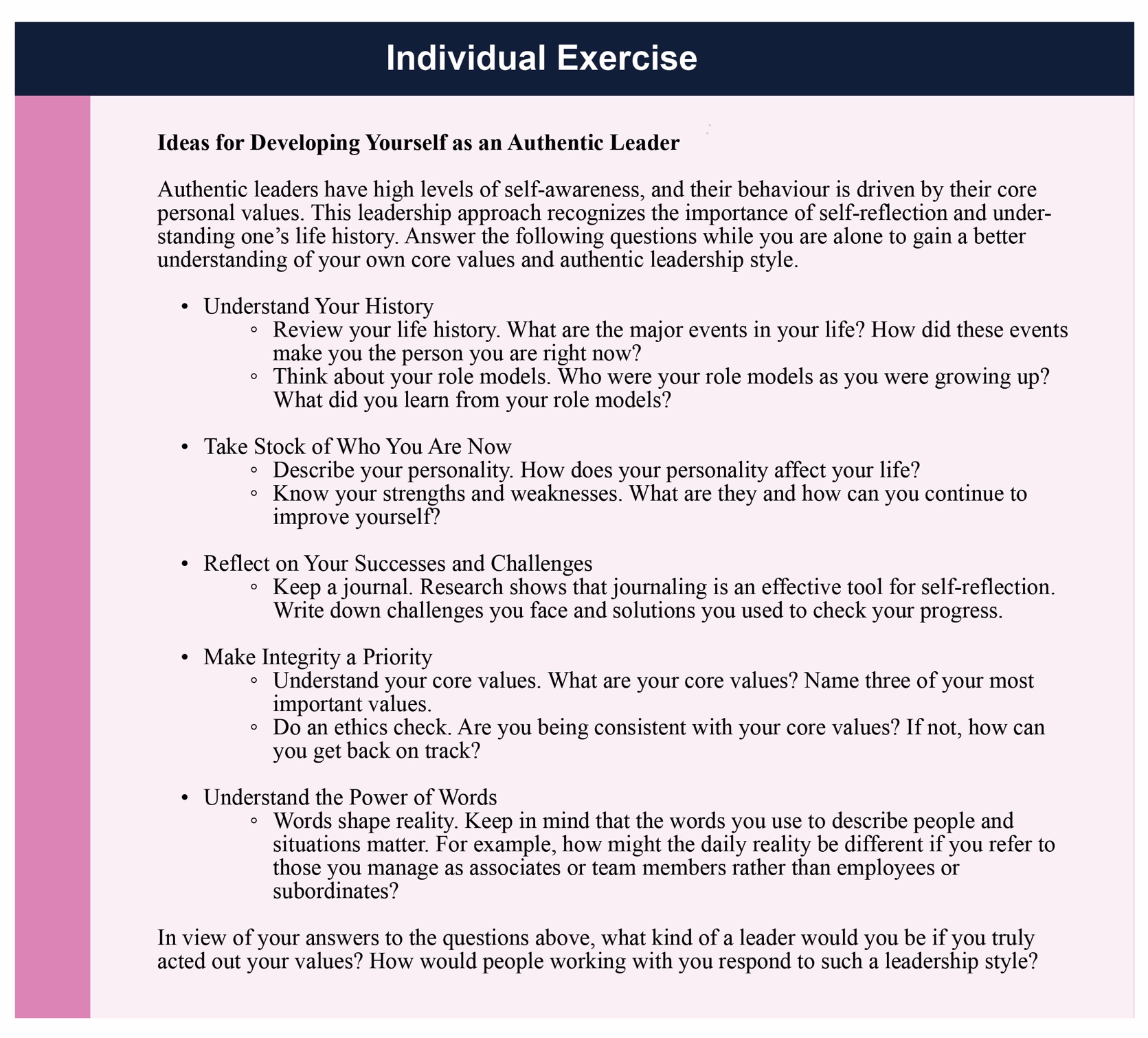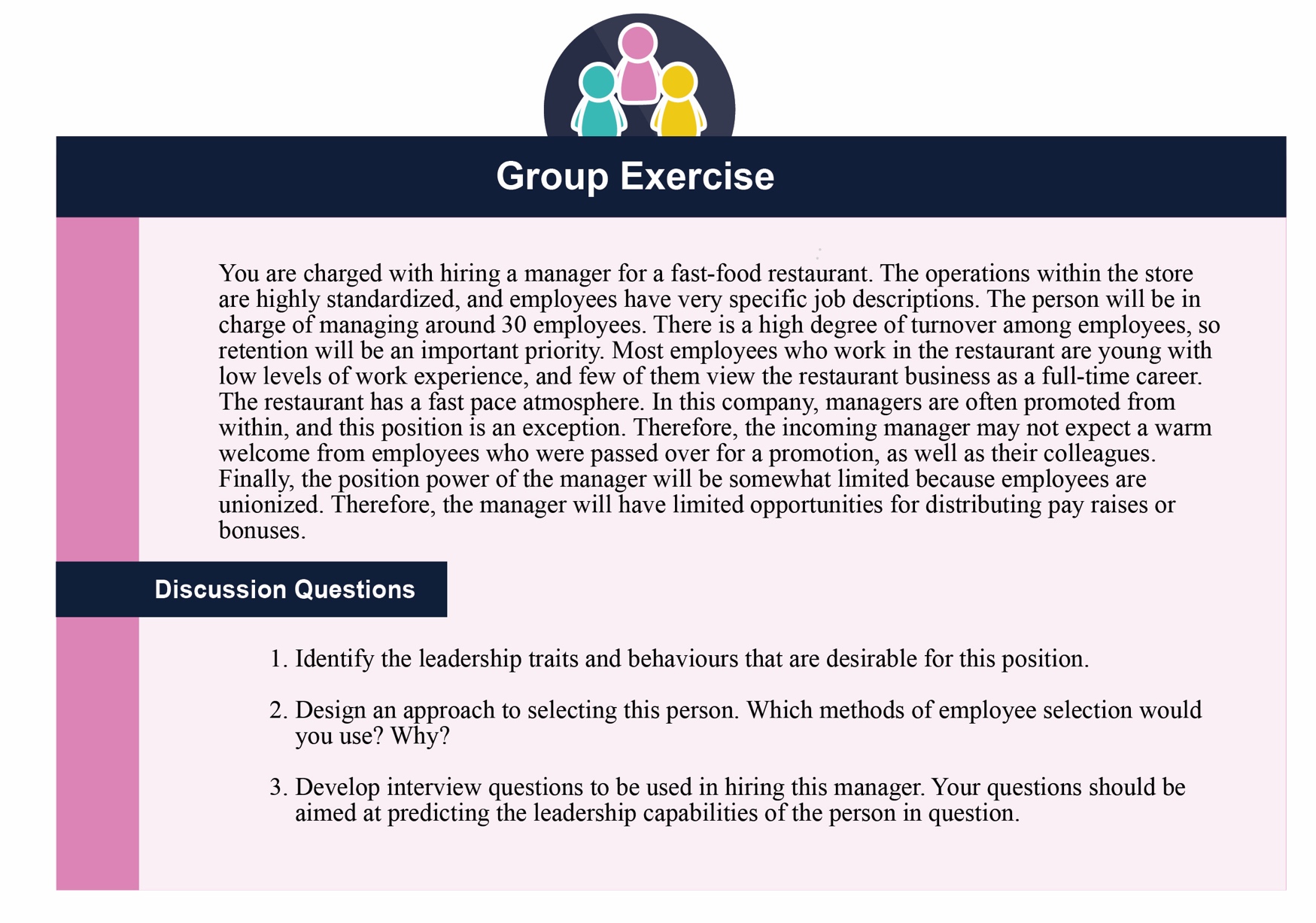Chapter 12: Leading People Within Organizations

Learning Objectives
After reading this chapter, you should be able to do the following:
- Define what leadership is and identify traits of effective leaders.
- Describe behaviours that effective leaders demonstrate.
- Specify the contexts in which various leadership styles are effective.
- Explain the concepts of transformational, transactional, servant, and authentic leadership.
Leadership may be defined as the act of influencing others to work toward a goal. Leaders exist at all levels of an organization. Some leaders hold a position of authority and may utilize the power that comes from their position, as well as their personal power to influence others. They are called formal leaders. In contrast, informal leaders are without a formal position of authority within the organization but demonstrate leadership by influencing others through personal forms of power. One caveat is important here: leaders do not rely on the use of force to influence people. Instead, people willingly adopt the leader’s goal as their own goal. If a person is relying on force and punishment, the person is a dictator, not a leader.
What makes leaders effective? What distinguishes people who are perceived as leaders from those who are not perceived as leaders? More importantly, how do we train future leaders and improve our own leadership ability? These are important questions that have attracted scholarly attention in the past several decades. In this chapter, we will review the history of leadership studies and summarize the major findings relating to these important questions. Around the world, we view leaders as at least partly responsible for their team or company’s success and failure. Company CEOs are paid millions of dollars in salaries and stock options with the assumption that they hold their company’s future in their hands. In politics, education, sports, profit and nonprofit sectors, the influence of leaders over the behaviours of individuals and organizations is rarely questioned. When people and organizations fail, managers and CEOs are often viewed as responsible. Some people criticize the assumption that leadership always matters and call this belief “the romance of leadership.” However, research evidence pointing to the importance of leaders for organizational success is accumulating (Hogan, Curphy, & Hogan, 1994).
12.1 Taking on the Pepsi Challenge: The Case of Indra Nooyi
She is among the top 100 most influential people according to Time magazine’s 2008 list. She is also number 5 in Forbes’s “Most Influential Women in the World” (2007), number 1 in Fortune’s “50 Most Powerful Women” (2006), and number 22 in Fortune’s “25 Most Powerful People in Business” (2007). The lists go on and on. To those familiar with her work and style, this should come as no surprise: even before she became the CEO of PepsiCo Inc. (NYSE: PEP) in 2006, she was one of the most powerful executives at PepsiCo and one of the two candidates being groomed for the coveted CEO position. Born in Chennai, India, Nooyi graduated from Yale’s School of Management and worked in companies such as the Boston Consulting Group Inc., Motorola Inc., and ABB Inc. She also led an all-girls rock band in high school, but that is a different story.

What makes her one of the top leaders in the business world today? To start with, she has a clear vision for PepsiCo, which seems to be the right vision for the company at this point in time. Her vision is framed under the term “performance with purpose,” which is based on two key ideas: tackling the obesity epidemic by improving the nutritional status of PepsiCo products and making PepsiCo an environmentally sustainable company. She is an inspirational speaker and rallies people around her vision for the company. She has the track record to show that she means what she says. She was instrumental in PepsiCo’s acquisition of the food conglomerate Quaker Oats Company and the juice maker Tropicana Products Inc., both of which have healthy product lines. She is bent on reducing PepsiCo’s reliance on high-sugar, high-calorie beverages, and she made sure that PepsiCo removed trans fats from all its products before its competitors. On the environmental side, she is striving for a net zero impact on the environment. Among her priorities are plans to reduce the plastic used in beverage bottles and find biodegradable packaging solutions for PepsiCo products. Her vision is long term and could be risky for short-term earnings, but it is also timely and important.
Those who work with her feel challenged by her high-performance standards and expectation of excellence. She is not afraid to give people negative feedback—and with humour, too. She pushes people until they come up with a solution to a problem and does not take “I don’t know” for an answer. For example, she insisted that her team find an alternative to expensive palm oil and did not stop urging them forward until the alternative arrived: rice bran oil.
Nooyi is well liked and respected because she listens to those around her, even when they disagree with her. Her background cuts across national boundaries, which gives her a true appreciation for diversity, and she expects those around her to bring their values to work. In fact, when she graduated from college, she wore a sari to a job interview at Boston Consulting, where she got the job. She is an unusually collaborative person in the top suite of a Fortune 500 company, and she seeks help and information when she needs it. She has friendships with three ex-CEOs of PepsiCo who serve as her informal advisors, and when she was selected to the top position at PepsiCo, she made sure that her rival for the position got a pay raise and was given influence in the company so she did not lose him. She says that the best advice she received was from her father, who taught her to assume that people have good intentions. Nooyi notes that expecting people to have good intentions helps her prevent misunderstandings and show empathy for them. It seems that she is a role model to other business leaders around the world, and PepsiCo is well positioned to tackle the challenges the future may bring (Birger et al., 2008; Brady, 2007; Compton, 2007; McKay, 2008; Morris & Neering, 2008; Schultz, 2008; The Pepsi challenge, 2006).
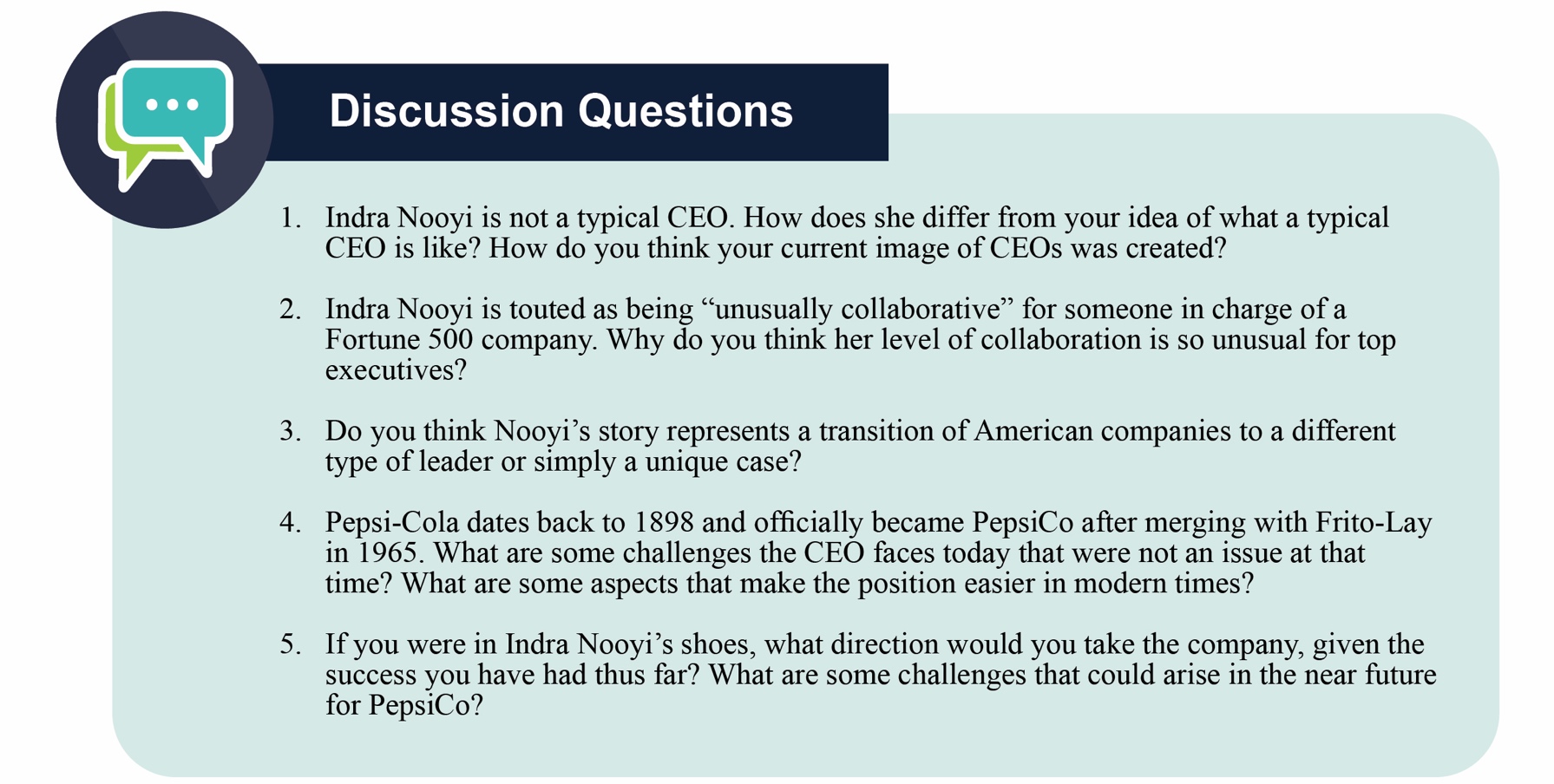
12.2 Who is a Leader? Trait Approaches to Leadership
The earliest approach to the study of leadership sought to identify a set of traits that distinguished leaders from non-leaders. What were the personality characteristics and the physical and psychological attributes of people who are viewed as leaders? Because of the problems in measurement of personality traits at the time, different studies used different measures. By 1940, researchers concluded that the search for leadership-defining traits was futile. In recent years, though, after the advances in personality literature such as the development of the Big Five personality framework, researchers have had more success in identifying traits that predict leadership (House & Aditya, 1997). Most importantly, charismatic leadership, which is among the contemporary approaches to leadership, may be viewed as an example of a trait approach.
The traits that show relatively strong relations with leadership are discussed below (Judge et al., 2002).
Intelligence
General mental ability, which psychologists refer to as “g” and which is often called “IQ” in everyday language, has been related to a person’s emergence as a leader within a group. Specifically, people who have high mental abilities are more likely to be viewed as leaders in their environment (House & Aditya, 1997; Ilies, Gerhardt, & Huy, 2004; Lord, De Vader, & Alliger, 1986; Taggar, Hackett, & Saha, 1999). We should caution, though, that intelligence is a positive but modest predictor of leadership, and when actual intelligence is measured with paper-and-pencil tests, its relationship to leadership is a bit weaker compared to when intelligence is defined as the perceived intelligence of a leader (Judge, Colbert, & Ilies, 2004). In addition to having a high IQ, effective leaders tend to have high emotional intelligence (EQ). People with high EQ demonstrate a high level of self-awareness, motivation, empathy, and social skills. The psychologist who coined the term emotional intelligence, Daniel Goleman, believes that IQ is a threshold quality: It matters for entry to high-level management jobs, but once you get there, it no longer helps leaders because most leaders already have a high IQ. According to Goleman, what differentiates effective leaders from ineffective ones becomes their ability to control their own emotions and understand other people’s emotions, their internal motivation, and their social skills (Goleman, 2004).
Big 5 Personality Traits

Psychologists have proposed various systems for categorizing the characteristics that make up an individual’s unique personality; one of the most widely accepted is the “Big Five” model, which rates an individual according to Openness to experience, Conscientiousness, Extraversion, Agreeableness, and Neuroticism. Several of the Big Five personality traits have been related to leadership emergence (whether someone is viewed as a leader by others) and effectiveness (Judge et al., 2002).
For example, extraversion is related to leadership. Extraverts are sociable, assertive, and energetic people. They enjoy interacting with others in their environment and demonstrate self-confidence. Because they are both dominant and sociable in their environment, they emerge as leaders in a wide variety of situations. Out of all personality traits, extraversion has the strongest relationship with both leader emergence and leader effectiveness. This is not to say that all effective leaders are extraverts, but you are more likely to find extraverts in leadership positions. An example of an introverted leader is Jim Buckmaster, the CEO of Craigslist. He is known as an introvert, and he admits to not having meetings because he does not like them (Buckmaster, 2008). Research shows that another personality trait related to leadership is conscientiousness. Conscientious people are organized, take initiative, and demonstrate persistence in their endeavors. Conscientious people are more likely to emerge as leaders and be effective in that role. Finally, people who have openness to experience—those who demonstrate originality, creativity, and are open to trying new things—tend to emerge as leaders and also be quite effective.
Self-Esteem
Self-esteem is not one of the Big Five personality traits, but it is an important aspect of one’s personality. The degree to which a person is at peace with oneself and has an overall positive assessment of one’s self worth and capabilities seem to be relevant to whether someone is viewed as a leader. Leaders with high self-esteem support their subordinates more and, when punishment is administered, they punish more effectively (Atwater et al., 1998; Niebuhr, 1984).
It is possible that those with high self-esteem have greater levels of self-confidence and this affects their image in the eyes of their followers. Self-esteem may also explain the relationship between some physical attributes and leader emergence. For example, research shows a strong relationship between being tall and being viewed as a leader (as well as one’s career success over life). It is proposed that self-esteem may be the key mechanism linking height to being viewed as a leader because people who are taller are also found to have higher self-esteem and therefore may project greater levels of charisma as well as confidence to their followers (Judge & Cable, 2004).
Integrity
Research also shows that people who are effective as leaders tend to have a moral compass and demonstrate honesty and integrity (Reave, 2005). Leaders whose integrity is questioned lose their trustworthiness, and they hurt their company’s business along the way. For example, when it was revealed that Whole Foods Market CEO, John Mackey, was using a pseudonym to make negative comments online about the company’s rival Wild Oats Markets Inc., his actions were heavily criticized, his leadership was questioned, and the company’s reputation was affected (Farrell & Davidson, 2007).
There are also some traits that are negatively related to leader emergence and being successful in that position. For example, agreeable people who are modest, good natured, and avoid conflict are less likely to be perceived as leaders (Judge et al., 2002).
Despite problems in trait approaches, these findings can still be useful to managers and companies. For example, knowing about leadership traits helps organizations select the right people into positions of responsibility. The key to benefiting from the findings of trait researchers is to be aware that not all traits are equally effective in predicting leadership potential across all circumstances. Some organizational situations allow leader traits to make a greater difference (House & Aditya, 1997). For example, in small, entrepreneurial organizations where leaders have a lot of leeway to determine their own behaviour, the type of traits leaders have may make a difference in leadership potential. In large, bureaucratic, and rule-bound organizations such as the government and the military, a leader’s traits may have less to do with how the person behaves and whether the person is a successful leader (Judge et al., 2002). Moreover, some traits become relevant in specific circumstances. For example, bravery is likely to be a key characteristic in military leaders, but not necessarily in business leaders. Scholars now conclude that instead of trying to identify a few traits that distinguish leaders from non-leaders, it is important to identify the conditions under which different traits affect a leader’s performance, as well as whether a person emerges as a leader (Hackman & Wageman, 2007).

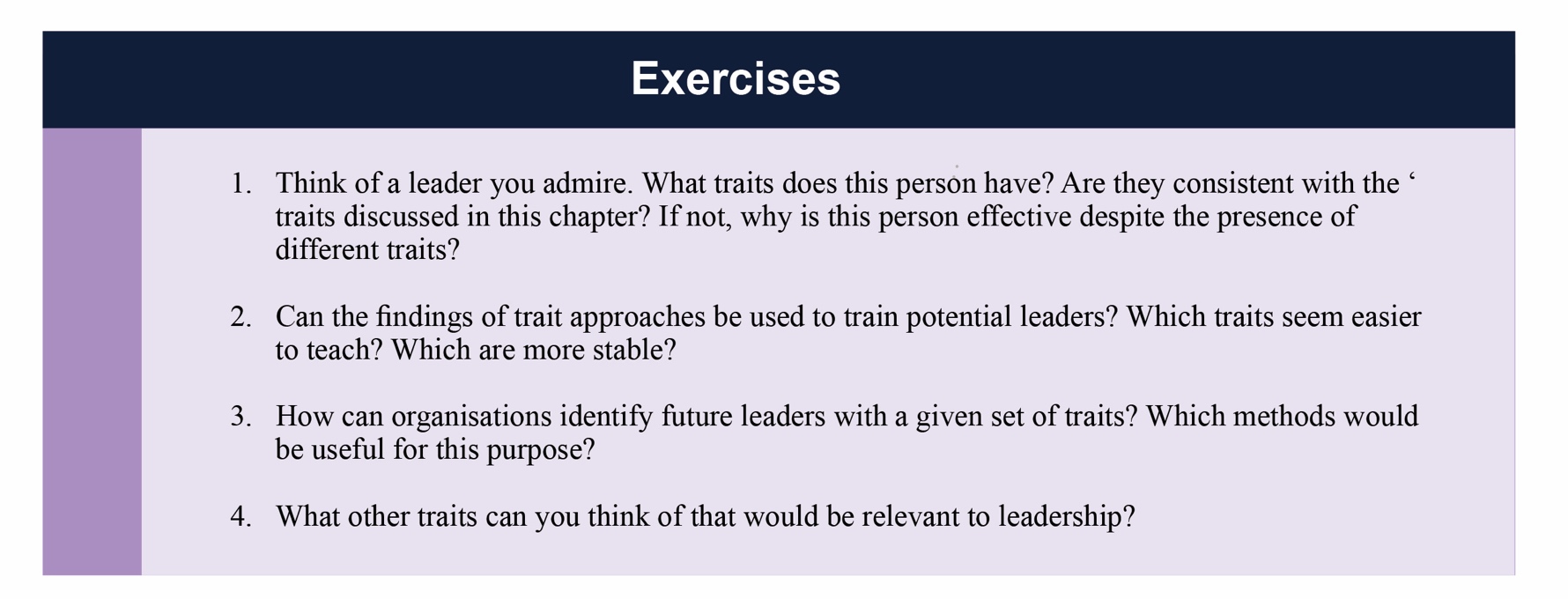
12.3 What Do Leaders Do? Behavioural Approaches to Leadership
Leader Behaviours
When trait researchers became disillusioned in the 1940s, their attention turned to studying leader behaviours. What did effective leaders actually do? Which behaviours made them perceived as leaders? Which behaviours increased their success? To answer these questions, researchers at Ohio State University and the University of Michigan used many different techniques, such as observing leaders in laboratory settings as well as surveying them. This research stream led to the discovery of two broad categories of behaviours: task-oriented behaviours (sometimes called initiating structure) and people-oriented behaviours (also called consideration). Task-oriented leader behaviours involve structuring the roles of subordinates, providing them with instructions, and behaving in ways that will increase the performance of the group. Task-oriented behaviours are directives given to employees to get things done and to ensure that organizational goals are met. People-oriented leader behaviours include showing concern for employee feelings and treating employees with respect. People-oriented leaders genuinely care about the wellbeing of their employees, and they demonstrate their concern in their actions and decisions. At the time, researchers thought that these two categories of behaviours were the keys to the puzzle of leadership (House & Aditya, 1997). However, research did not support the argument that demonstrating both of these behaviours would necessarily make leaders effective (Nystrom, 1978).
When we look at the overall findings regarding these leadership behaviours, it seems that both types of behaviours, in the aggregate, are beneficial to organizations, but for different purposes. For example, when leaders demonstrate people-oriented behaviours, employees tend to be more satisfied and react more positively. However, when leaders are task oriented, productivity tends to be a bit higher (Judge, Piccolo, & Ilies, 2004). Moreover, the situation in which these behaviours are demonstrated seems to matter. In small companies, task-oriented behaviours were found to be more effective than in large companies (Miles & Petty, 1977). There is also some evidence that very high levels of leader task-oriented behaviours may cause burnout with employees (Seltzer & Numerof, 1988).
Leader Decision Making
Another question behavioural researchers focused on involved how leaders actually make decisions and the influence of decision-making styles on leader effectiveness and employee reactions. Three types of decision-making styles were studied. In authoritarian decision making, leaders make the decision alone without necessarily involving employees in the decision-making process. When leaders use democratic decision making, employees participate in the making of the decision. Finally, leaders using laissez-faire decision making leave employees alone to make the decision. The leader provides minimum guidance and involvement in the decision.
As with other lines of research on leadership, these studies did not identify one decision-making style as the best. It seems that the effectiveness of the style the leader is using depends on the circumstances. A review of the literature shows that when leaders use more democratic or participative decision-making styles, employees tend to be more satisfied; however, the effects on decision quality or employee productivity are weaker. Moreover, instead of expecting to be involved in every single decision, employees seem to care more about the overall prescriptiveness of the organizational climate (Miller & Monge, 1986). Different types of employees may also expect different levels of involvement. In a research organization, scientists viewed democratic leadership most favorably and authoritarian leadership least favorably (Baumgartel, 1957), but employees working in large groups where opportunities for member interaction was limited preferred authoritarian leader decision making (Vroom & Mann, 1960). Finally, the effectiveness of each style seems to depend on who is using it. There are examples of effective leaders using both authoritarian and democratic styles. At Hyundai Motor America, high-level managers use authoritarian decision-making styles, and the company is performing very well (Deutschman, 2004; Welch, Kiley, & Ihlwan, 2008).

The track record of the laissez-faire decision-making style is more problematic. Research shows that this style is negatively related to employee satisfaction with leaders and leader effectiveness (Judge & Piccolo, 2004). Laissez-faire leaders create high levels of ambiguity about job expectations on the part of employees, and employees also engage in higher levels of conflict when leaders are using the laissez- faire style (Skogstad et al., 2007).
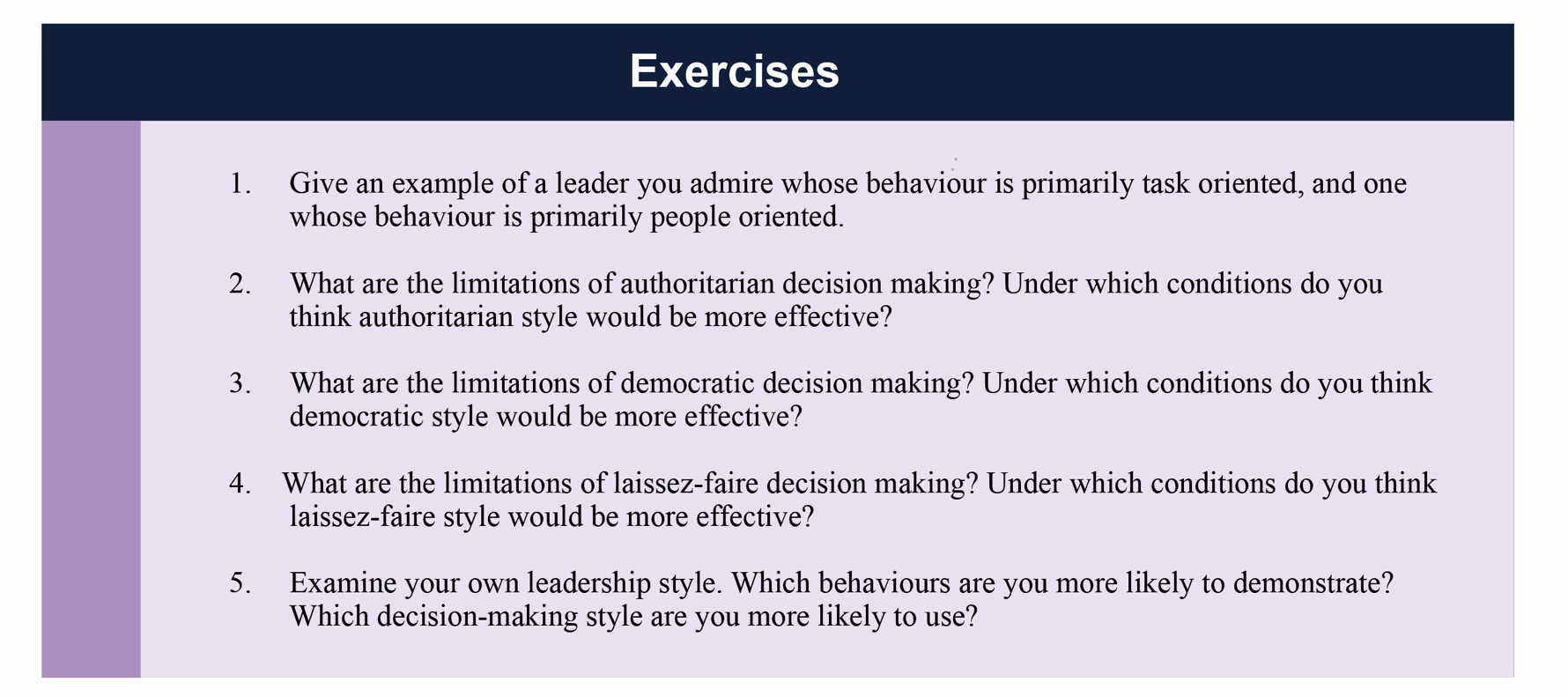
12.4 Mini Case Scenario
START OF SEASON
LEADERSHIP STYLE SETS A TONE
You have just been promoted to be the manager of a rafting company that you have worked for over the last three summers. As a guide, the biggest problem you see is that many guides show up to start their work day at 9:30 rather than the 9 a.m. start time. When guides show up late, the work to prepare the rafts falls to two few people and it causes delays to the start of the day’s activities. You decide that you are going to start the year off by addressing this issue. Your message is, “Lateness will not be tolerated and guides will be terminated for being more than 30 minutes late.” You clearly communicate this work rule to all guides during their one-day training session, held a week before the summer season begins.
The night before the first day of opening, all the retuning raft captains have a big party on the beach. As you are expecting a large group of 200 students from Montreal to arrive at the site the next day, you remind all guides before the party that the start time the next day is 9 a.m. and everybody needs to be ready to launch the rafts on time. Ten guides are scheduled to start at 9 a.m. the next day.
At 9 a.m., nine guides appear, ready for the day. David, a veteran guide and one of the best, does not show until 9:32.
You have two options: 1) terminate David or, 2) reprimand David. What option should you choose? How do you justify your decision?
The Twist
The guides get together and inform you that that all of them will be calling in sick the next day, just when another large group is coming in. The guides have been complaining that your leadership style is creating an unfriendly and hostile workplace.
What do you do? What have you learned from this experience?
© Ted Rogers Leadership Centre. This case is made available for public use under a Creative Commons Attribution-Non Commercial-No Derivs (CC BY-NC-ND) license.
Contingency Approaches to Leadership
What is the best leadership style? By now, you must have realized that this may not be the right question to ask. Instead, a better question might be: under which conditions are certain leadership styles more effective? After the disappointing results of trait and behavioural approaches, several scholars developed leadership theories that specifically incorporated the role of the environment. Specifically, researchers started following a contingency approach to leadership—rather than trying to identify traits or behaviours that would be effective under all conditions, the attention moved toward specifying the situations under which different styles would be effective.
Situational Leadership
Another contingency approach to leadership is Kenneth Blanchard and Paul Hersey’s Situational Leadership Theory (SLT) which argues that leaders must use different leadership styles depending on their followers’ development level (Hersey, Blanchard, & Johnson, 2007). According to this model, employee readiness (defined as a combination of their competence and commitment levels) is the key factor determining the proper leadership style. This approach has been highly popular with 14 million managers across 42 countries undergoing SLT training and 70% of Fortune 500 companies employ its use.
The model summarizes the level of directive and supportive behaviours that leaders may exhibit. The model argues that to be effective, leaders must use the right style of behaviours at the right time in each employee’s development. It is recognized that followers are key to a leader’s success. Employees who are at the earliest stages of development are seen as being highly committed but with low competence for the tasks. Thus, leaders should be highly directive and less supportive. As the employee becomes more competent, the leader should engage in more coaching behaviours. Supportive behaviours are recommended once the employee is at moderate to high levels of competence. And finally, delegating is the recommended approach for leaders dealing with employees who are both highly committed and highly competent. While the SLT is popular with managers, relatively easy to understand and use, and has endured for decades, it received mixed support from research on the basic assumptions of the model (Blank, Green, & Weitzel, 1990; Graeff, 1983; Fernandez & Vecchio, 2002). Therefore, while it can be a useful way to think about matching behaviours to situations, overreliance on this model, at the exclusion of other models, is premature.

Path-Goal Theory of Leadership
Robert House’s path-goal theory of leadership is based on the expectancy theory of motivation (House, 1971). The expectancy theory of motivation suggests that employees are motivated when they believe—or expect—that (a) their effort will lead to high performance, (b) their high performance will be rewarded, and (c) the rewards they will receive are valuable to them. According to the path-goal theory of leadership, the leader’s main job is to make sure that all three of these conditions exist. Thus, leaders will create satisfied and high-performing employees by making sure that employee effort leads to performance, and their performance is rewarded by desired rewards. The leader removes roadblocks along the way and creates an environment that subordinates find motivational.
The theory also makes specific predictions about what type of leader behaviour will be effective under which circumstances (House, 1996; House & Mitchell, 1974). The theory identifies four leadership styles. Each of these styles can be effective, depending on the characteristics of employees (such as their ability level, preferences, locus of control, and achievement motivation) and characteristics of the work environment (such as the level of role ambiguity, the degree of stress present in the environment, and the degree to which the tasks are unpleasant).
Four Leadership Styles
Directive leaders provide specific directions to their employees. They lead employees by clarifying role expectations, setting schedules, and making sure that employees know what to do on a given work day. The theory predicts that the directive style will work well when employees are experiencing role ambiguity on the job. If people are unclear about how to do their jobs, giving them specific directions will motivate them. On the other hand, if employees already have role clarity, and if they are performing boring, routine, and highly structured jobs, giving them direction does not help. In fact, it may hurt them by creating an even more restricting atmosphere. Directive leadership is also thought to be less effective when employees have high levels of ability. When managing professional employees with high levels of expertise and job-specific knowledge, telling them what to do may create a low-empowerment environment, which impairs motivation.
Supportive leaders provide emotional support to employees. They treat employees well, care about them on a personal level, and they are encouraging. Supportive leadership is predicted to be effective when employees are under a lot of stress or performing boring, repetitive jobs. When employees know exactly how to perform their jobs but their jobs are unpleasant, supportive leadership may be more effective.
Participative leaders make sure that employees are involved in the making of important decisions. Participative leadership may be more effective when employees have high levels of ability, and when the decisions to be made are personally relevant to them. For employees with a high internal locus of control (those who believe that they control their own destiny), participative leadership is a way of indirectly controlling organizational decisions, which is likely to be appreciated.
Achievement-oriented leaders set goals for employees and encourage them to reach their goals. Their style challenges employees and focuses their attention on work-related goals. This style is likely to be effective when employees have both high levels of ability and high levels of achievement motivation.
The path-goal theory of leadership has received partial but encouraging levels of support from researchers. Because the theory is highly complicated, it has not been fully and adequately tested (House & Aditya, 1997; Stinson & Johnson, 1975; Wofford & Liska, 1993). The theory’s biggest contribution may be that it highlights the importance of a leader’s ability to change styles depending on the circumstances. Unlike Fiedler’s contingency theory, in which the leader’s style is assumed to be fixed and only the environment can be changed, House’s path-goal theory underlines the importance of varying one’s style depending on the situation.

12.5 Mini Case Scenario
LEADERSHIP WITH STYLE
WHAT IS THE BEST WAY TO COACH AN EMPLOYEE?
You are the assistant manager in the Galaxy Wine Bar, located in a busy downtown Toronto hotel, close to the Rogers Centre. It is 2:30 am. You are in the back office doing some paperwork when one of your servers comes to report a problem with a group of customers. The customers are a group of 18 sports fans. They are guests at the hotel and have come to the bar at midnight following the Stanley Cup win by their beloved Habs, the Montreal team. Since midnight, the group has ordered an impressive amount of food as well as many expensive bottles of wine. At last call, at 1:45 am, they ordered more wine and food. Now, at 2:30 am, they are getting angry at their server who has informed them that the bar is closing in fifteen minutes, at 2:45am, as required by Ontario’s liquor licensing laws. The group wants to continue to party and relive the big moments of the game.
You have had a lot of experience dealing with situations like this. You know that it might be possible to move the party upstairs to the guests’ hotel rooms. You hesitate, wondering if you should just take over or use this as an opportunity to coach an employee on how to manage the situation themselves. Time, however, is short.
As a leader, what are your next steps?
© Ted Rogers Leadership Centre. This case is made available for public use under a Creative Commons Attribution-Non Commercial-No Derivs (CC BY-NC-ND) license.
Contemporary Approaches to Leadership
What are the leadership theories that have the greatest contributions to offer to today’s business environment? In this section, we will review the most recent developments in the field of leadership.
Transformational Leadership
Transformational leadership theory is a recent addition to the literature, but more research has been conducted on this theory than all the contingency theories combined. The theory distinguishes transformational and transactional leaders. Transformational leaders lead employees by aligning employee goals with the leader’s goals. Thus, employees working for transformational leaders start focusing on the company’s well-being rather than on what is best for them as individual employees. On the other hand, transactional leaders ensure that employees demonstrate the right behaviours and provide resources in exchange (Bass, 1985; Burns, 1978).
Transformational leaders have four tools in their possession, which they use to influence employees and create commitment to the company goals (Bass, 1985; Burns, 1978; Bycio, Hackett, & Allen, 1995; Judge & Piccolo, 2004). First, transformational leaders are charismatic. Charisma refers to behaviours leaders demonstrate that create confidence in, commitment to, and admiration for the leader (Shamir, House, & Arthur, 1993). Charismatic individuals have a “magnetic” personality that is appealing to followers. Second, transformational leaders use inspirational motivation, or come up with a vision that is inspiring to others. Third is the use of intellectual stimulation, which means that they challenge organizational norms and status quo, and they encourage employees to think creatively and work harder. Finally, they use individualized consideration, which means that they show personal care and concern for the well-being of their followers. Examples of transformational leaders include Steve Jobs of Apple Inc.; Lee Iaccoca, who transformed Chrysler Motors LLC in the 1980s; and Jack Welch, who was the CEO of General Electric Company for 20 years. Each of these leaders is charismatic and is held responsible for the turnarounds of their companies.
While transformational leaders rely on their charisma, persuasiveness, and personal appeal to change and inspire their companies, transactional leaders use three different methods. Contingent rewards mean rewarding employees for their accomplishments. Active management by exception involves leaving employees to do their jobs without interference, but at the same time proactively predicting potential problems and preventing them from occurring. Passive management by exception is similar in that it involves leaving employees alone, but in this method the manager waits until something goes wrong before coming to the rescue.
Which leadership style do you think is more effective, transformational or transactional? Research shows that transformational leadership has a very powerful influence over leader effectiveness as well as employee satisfaction (Judge & Piccolo, 2004). In fact, transformational leaders increase the intrinsic motivation of their followers, build more effective relationships with employees, increase performance and creativity of their followers, increase team performance, and create higher levels of commitment to organizational change efforts (Herold et al., 2008; Piccolo & Colquitt, 2006; Schaubroeck, Lam, & Cha, 2007; Shin & Zhou, 2003; Wang et al., 2005). However, except for passive management by exception, the transactional leadership styles are also effective, and they also have positive influences over leader performance as well as employee attitudes (Judge & Piccolo, 2004). To maximize their effectiveness, leaders are encouraged to demonstrate both transformational and transactional styles. They should also monitor themselves to avoid demonstrating passive management by exception or leaving employees to their own devices until problems arise.
Why is transformational leadership effective? The key factor may be trust. Trust is the belief that the leader will show integrity, fairness, and predictability in his or her dealings with others. Research shows that when leaders demonstrate transformational leadership behaviours, followers are more likely to trust the leader. The tendency to trust in transactional leaders is substantially lower. Because transformational leaders express greater levels of concern for people’s well-being and appeal to people’s values, followers are more likely to believe that the leader has a trustworthy character (Dirks & Ferrin, 2002).
Servant Leadership
The early 21st century has been marked by a series of highly publicized corporate ethics scandals: between 2000 and 2003 we witnessed the scandals of Enron, WorldCom, Arthur Andersen LLP, Qwest Communications International Inc., and Global Crossing Ltd. As corporate ethics scandals shake investor confidence in corporations and leaders, the importance of ethical leadership and keeping long-term interests of stakeholders in mind is becoming more widely acknowledged.
Servant leadership is a leadership approach that defines the leader’s role as serving the needs of others. According to this approach, the primary mission of the leader is to develop employees and help them reach their goals. Servant leaders put their employees first, understand their personal needs and desires, empower them, and help them develop in their careers. Unlike mainstream management approaches, the overriding objective in servant leadership is not limited to getting employees to contribute to organizational goals. Instead, servant leaders feel an obligation to their employees, customers, and the external community. Employee happiness is seen as an end in itself, and servant leaders sometimes sacrifice their own well-being to help employees succeed. In addition to a clear focus on having a moral compass, servant leaders are also interested in serving the community. In other words, their efforts to help others are not restricted to company insiders, and they are genuinely concerned about the broader community surrounding their organization (Greenleaf, 1977; Liden et al., 2008). According to historian Doris Kearns Goodwin, Abraham Lincoln was a servant leader because of his balance of social conscience, empathy, and generosity (Goodwin, 2005).
Even though servant leadership has some overlap with other leadership approaches such as transformational leadership, its explicit focus on ethics, community development, and self-sacrifice are distinct characteristics of this leadership style. Research shows that servant leadership has a positive impact on employee commitment, employee citizenship behaviours toward the community (such as participating in community volunteering), and job performance (Liden et al., 2008). Leaders who follow the servant leadership approach create a climate of fairness in their departments, which leads to higher levels of interpersonal helping behaviour (Ehrhart, 2004).
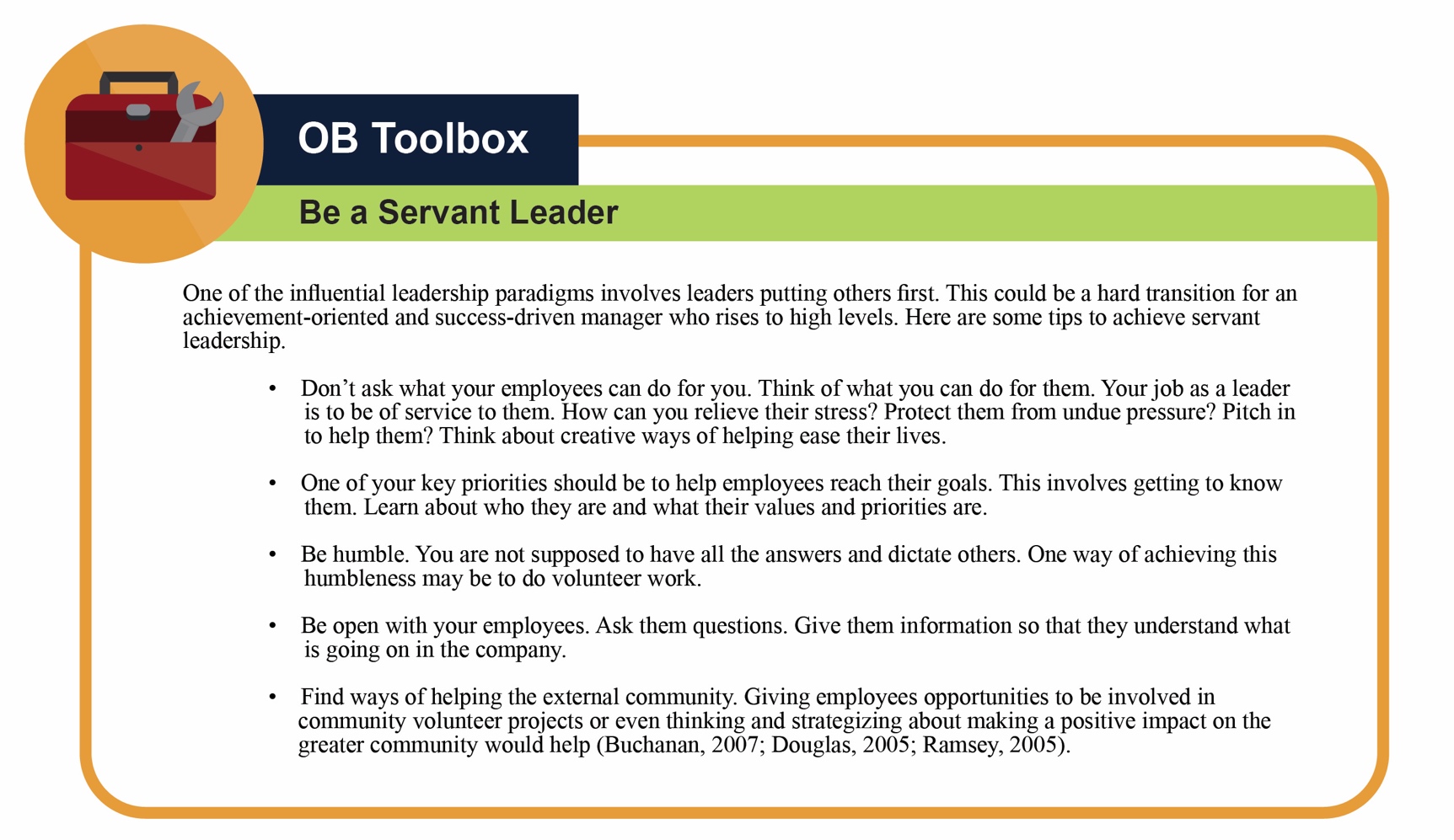
Authentic Leadership
Leaders have to be a lot of things to a lot of people. They operate within different structures, work with different types of people, and must be adaptable. At times, it may seem that a leader’s smartest strategy would be to act as a social chameleon, changing his or her style whenever doing so seems advantageous. But this would lose sight of the fact that effective leaders must stay true to themselves. The authentic leadership approach embraces this value: Its key advice is “be yourself.” Think about it: we all have different backgrounds, life experiences, and role models. These trigger events over the course of our lifetime that shape our values, preferences, and priorities. Instead of trying to fit into societal expectations about what a leader should be, act like, or look like, authentic leaders derive their strength from their past experiences. Thus, one key characteristic of authentic leaders is that they are self-aware. They are introspective, understand where they are coming from, and thoroughly understand their own values and priorities. Secondly, they are not afraid to act the way they are. In other words, they have high levels of personal integrity. They say what they think. They behave in a way consistent with their values. As a result, they remain true to themselves. Instead of trying to imitate other great leaders, they find their own style in their personality and life experiences (Avolio & Gardner, 2005; Gardner et al., 2005; George, 2007; Ilies, Morgeson, & Nahrgang, 2005; Sparrowe, 2005).
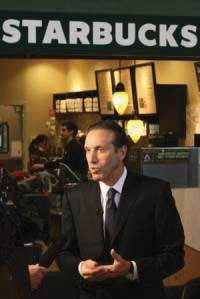
One example of an authentic leader is Howard Schultz, the founder of Starbucks Corporation coffeehouses. As a child, Schultz witnessed the job-related difficulties his father experienced due to medical problems. Even though he had no idea he would have his own business one day, the desire to protect people was shaped in those years and became one of his foremost values. When he founded Starbucks, he became an industry pioneer by providing health insurance and retirement coverage to part-time and full-time employees (Shamir & Eilam, 2005).
Authentic leadership requires understanding oneself. Therefore, in addition to self-reflection, feedback from others is needed to understand one’s behavior and its impact on others. Authentic leadership is viewed as potentially influential because employees are more likely to trust such a leader. Moreover, working for an authentic leader is likely to lead to greater satisfaction, performance, and overall well-being on the part of employees (Walumbwa et al., 2008).
Authentic leadership does not mean embracing your leadership style by being true to yourself regardless of the negative impacts it may be having on others. For example, Experts on workplace leadership assert that so far, Elon Musk’s leadership style is headed in the wrong direction. In a recent Forbes.com interview, Jenn Lim, CEO of Delivering Happiness and author of BeyondHappiness: How Authentic Leaders Prioritize Purpose for Growth and Impact, reported that Musk “treats people like collateral damage instead of human beings, forgetting basic human decency in the way he’shandling the layoffs. Lim’s appraisal raises the question of what impact his inhumane actions will have on employees’ already bruised mental health. Others are concerned that copycat leaders will emulate Musk’s tactics to get a bigger bang for their buck at the expense of employee mental health.” (Robinson, 2022, p. 2)
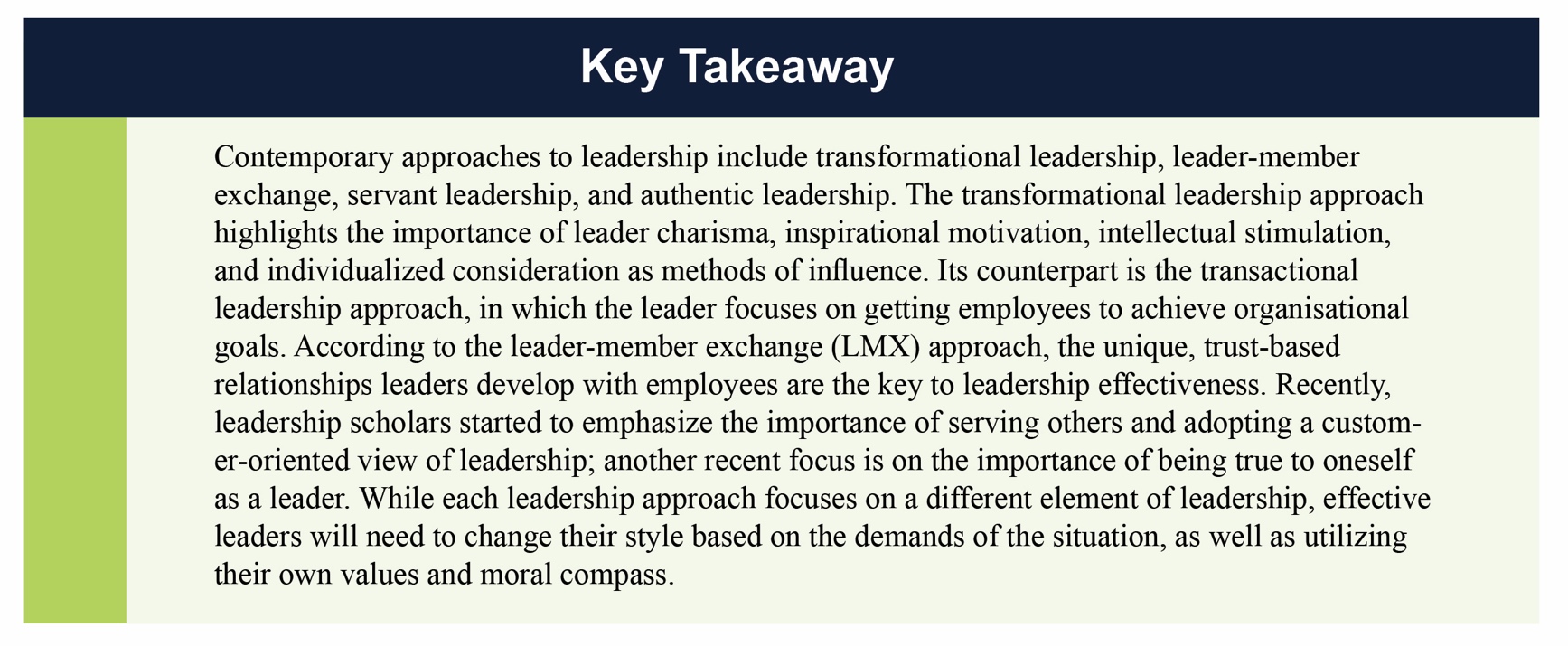
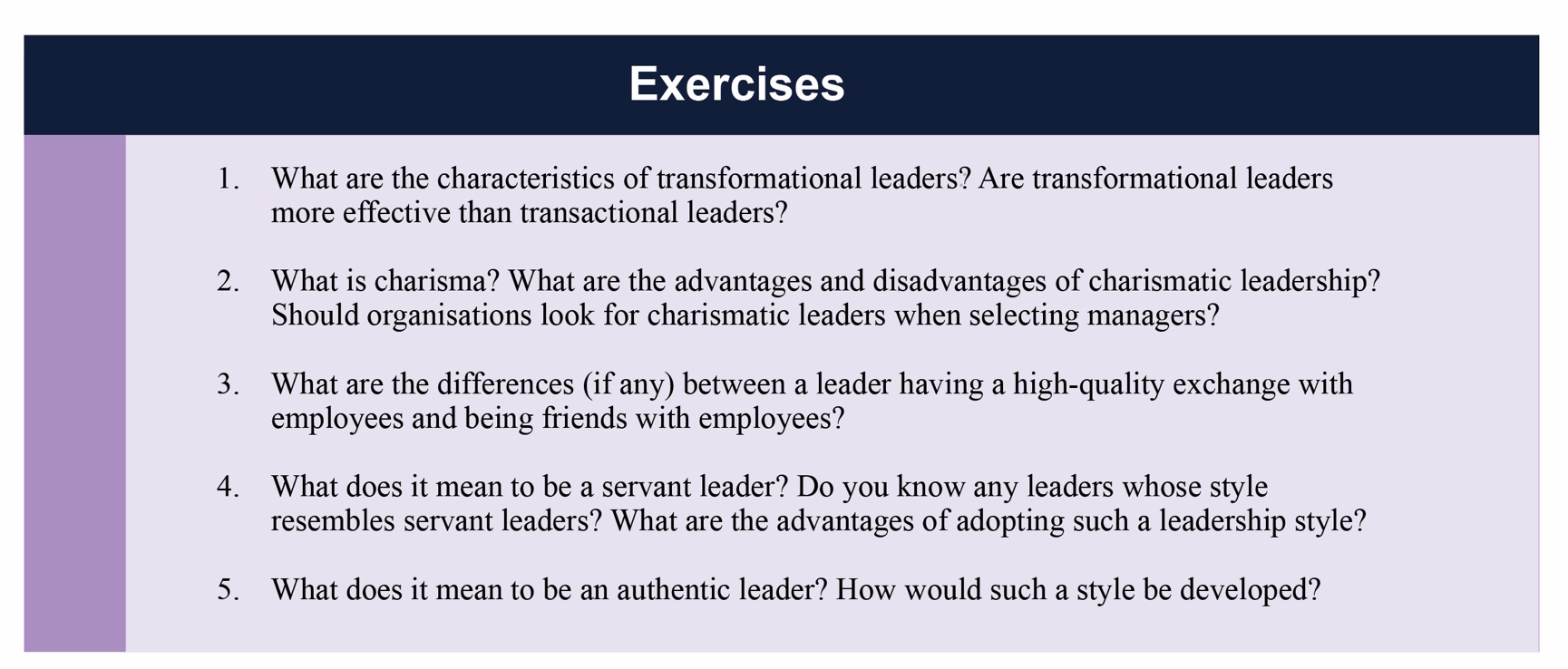
12.6 Leadership Around the Globe
Is leadership universal? This is a critical question given the amount of international activity in the world. Companies that have branches in different countries often send expatriates to manage the operations. These expatriates are people who have demonstrated leadership skills at home, but will these same skills work in the host country? Unfortunately, this question has not yet been fully answered. All the leadership theories that we describe in this chapter are U.S.-based. Moreover, around 98% of all leadership research has been conducted in the United States and other western nations. Thus, these leadership theories may have underlying cultural assumptions. The United States is an individualistic, performance-oriented culture, and the leadership theories suitable for this culture may not necessarily be suitable to other cultures.
People who are perceived as leaders in one society may have different traits compared to people perceived as leaders in a different culture because each society has a concept of ideal leader prototypes. When we see certain characteristics in a person, we make the attribution that this person is a leader. For example, someone who is confident, caring, and charismatic may be viewed as a leader because we feel that these characteristics are related to being a leader. These leadership prototypes are societally driven and may have a lot to do with a country’s history and its heroes.
Recently, a large group of researchers from 62 countries came together to form a project group called Global Leadership and Organizational Behaviour Effectiveness or GLOBE (House et al., 2004). This group is one of the first to examine leadership differences around the world. Their results are encouraging because in addition to identifying differences, they found similarities in leadership styles as well. Specifically, certain leader traits seem to be universal. Around the world, people feel that honesty, decisiveness, being trustworthy, and being fair are related to leadership effectiveness. There is also universal agreement in characteristics viewed as undesirable in leaders: being irritable, egocentric, and a loner (Den Hartog et al., 1999; Javidan et al., 2006). Visionary and charismatic leaders were found to be the most influential leaders around the world, followed by team-oriented and participative leaders. In other words, there seems to be a substantial generalizability in some leadership styles.
Even though certain leader behaviours such as charismatic or supportive leadership appear to be universal, what makes someone charismatic or supportive may vary across nations. For example, when leaders fit the leadership prototype, they tend to be viewed as charismatic, but in Turkey, if they are successful but did not fit the prototype, they were still viewed as charismatic (Ensari & Murphy, 2003). In Western and Latin cultures, people who speak in an emotional and excited manner may be viewed as charismatic. In Asian cultures such as China and Japan, speaking in a monotonous voice may be more impressive because it shows that the leader can control emotions. Similarly, how leaders build relationships or act supportively is culturally determined. In collectivist cultures such as Turkey or Mexico, a manager is expected to show personal interest in employees’ lives. Visiting an employee’s sick mother at the hospital may be a good way of showing concern. Such behaviour would be viewed as intrusive or strange in the United States or the Netherlands. Instead, managers may show concern verbally or by lightening the workload of the employee (Brodbeck et al., 2000; Den Hartog et al., 1999).
There were also many leader characteristics that vary across cultures (Dorfman et al., 1997; Gerstner & Day, 1994). Traits such as being autonomous, conflict avoidant, status conscious, and ambitious were culturally dependent. For example, in France, employees do not expect their leaders to demonstrate empathy. Leaders demonstrating self-sacrifice are also viewed negatively, suggesting that servant leadership style would be be suitable there. In Middle Eastern cultures such as Egypt, leaders are expected to be superior to lay people. They are supposed to have all the answers, be confident, and authoritarian. In fact, leading like a benevolent autocrat (someone who cares about people but acts alone) may be an appropriate style (Javidan et al., 2006). Even within the same geography, researchers identified substantial cultural differences. For example, in Europe, there were five clusters of cultures. Directness in interpersonal relationships was viewed positively in Nordic cultures such as Finland, but negatively in Near Eastern cultures such as Turkey. Similarly, leaders who are autonomous were viewed positively in Germanic cultures such as Austria, but negatively in Latin European cultures such as Portugal (Brodbeck et al., 2000). Finally, in some cultures, good leaders are paternalistic. These leaders act like a parent to employees, give advice, care for them, and get obedience and loyalty in return (Aycan et al., 2000; Pellegrini & Scandura, 2008).
Given all these differences, effective leaders should develop a sensitivity to cultural differences and adapt their style when they work in different societies or with people from different cultural backgrounds. It seems that flexibility is an important trait for global leaders.
In addition to the locations and cultures around the globe, cultural aspects, even within one country, must always be considered when determining the best leadership style to be used, there are cultural values, assumptions, and preferences regarding acceptable leadership styles. For example, among many Indigenous populations, leadership styles that are consultative and community-oriented are critical for successful interpersonal relationships. Specifically, as described by the Ontario Native Education Counselling Association (Indigenous Leadership, retrieved on April 23rd 2023 from https://oneca.com/wp-content/uploads/2019/11/Indigenous-Leadership.pdf), character traits of effective Indigenous leaders and managers include:
- Effective listener and communicator
- Strong in cultural and spiritual identity
- Respectful in all relationships with people and the natural world
- Puts community first before individual needs
- Builds community by being inclusive, welcoming, and valuing the perspectives of others
- Makes decisions for future generations of those yet unborn
- Is guided by ancestors, elders, and advisors
- Makes decisions by consensus (democratic)
- Charismatic – the people respect and want to follow
- Encouraging and supportive, helps others find their gifts
- Visionary
- Family oriented
- Continuously works to fulfill their responsibility to the people and community
- Knowledgeable on many fronts and willingly shares knowledge
- Accountable to the people
12.7 Leadership Development: The Case of Starbucks
Starbucks Coffee (NASDAQ: SBUX) was born out of a desire for convenience and accessibility to great coffee. In 1971, three friends made that desire a reality and established the first Starbucks coffee house in historic Pike Place Market on Seattle’s waterfront. In 1990, Starbucks drafted its first mission statement, and the number one principle was to “provide a great work environment and treat each other with respect and dignity.” How has the company lived up to that declaration 20 years later? Starbucks has consistently made Fortune magazine’s “100 Best Companies to Work For” list and in addition, is included on a list of the best places to work for LGBT (lesbian, gay, bisexual, and transgender) equality. Working conditions in the service and retail industry are notoriously low paying with long hours, but Starbucks manages to offer benefits for part-time and full-time employees as well as higher-than-average salaries for store managers. Why, one might ask, does Starbucks try so hard to set itself apart?

Leadership development is a core element of the business process at Starbucks, which ensures that the organizational culture of the company is maintained with every CEO successor. Starbucks is forward looking in this respect and strives to attract future business leaders and managers. The idea of planning for one’s own succession can often make people uneasy, but this idea is openly embraced at Starbucks. The company plans far in advance to replace its top-level successors. The importance of leadership is not only ingrained in the upper management team, but Starbucks also ensures that this is an understood value throughout the organization. In 2004, the Coffee Master program was introduced to teach employees about regional coffee flavours. Graduates of the Coffee Master program earn a prestigious black apron and a special insignia on their business cards. In creating this ethos, Starbucks excels at its ability to attract an educated workforce with a high satisfaction level where individuals often move up to become effective leaders within the company.
With the recession of 2009, Starbucks has been forced to rethink its traditional strategy of accelerated growth by closing over 30,000 stores. CEO Howard Schultz has cut his salary to less than $10,000 a year, down from $1.2 million. Despite these slowdowns, Starbucks continues to call employees “partners” and offers a dynamic place to work. As a result, the company had more than 150,000 people apply for jobs last year, a sure indication that the company’s ability to cultivate talented leaders is as strong as ever (100 best companies, 2010; Cohn, Khurana & Reeves, 2005; Helm, 2007; Miller, 2009; Stanley, 2002).
12.8 Ethics in Leadership
Ethics recently became an explicit focus of leadership theories such as servant leadership and authentic leadership. It seems that being conscious of one’s style and ensuring that leaders demonstrate the behaviors that address employee, organizational, and stakeholder needs are important and require flexibility on the part of leaders. In an infamous case related to unethical leadership practices by a brilliant leader, Elizabeth Holmes dropped out of Stanford University. She founded blood testing startup Theranos in 2003, which promised a revolutionized the way medical procedures around blood collection were handled. Theranos raised more than $700 million from investors, and Forbes named Holmes the world’s youngest self-made woman billionaire–worth $4.5 billion–in 2014 when she was 30 years old. Starting in 2015, Theranos’ technology came into question; reporting by The Wall Street Journal revealed that Theranos was using other companies’ machines. Forbes revised our net worth estimate for Holmes to $0 in June 2016 amid new information and as the company faced a slew of investigations from federal agencies. On January 3, 2022, Holmes was found guilty of four out of 11 charges of fraud; she was acquitted on four charges; the jury failed to reach a verdict on 3 counts.
12.9 Leading a Virtual Team
The COVID-19 pandemic forced more Canadian workers to work remotely, of whom many remain working at least in a hybrid model consisting of working from the office and working from home. This shift to more remote work created a need for leaders to learn new skills and strategies for managing and engaging a remote team. In a research study examining the impact of leadership behavior, team effectiveness, technological flexibility, work engagement, and performance during the COVID-19 lockdown, Koekemoer, De Beer, Govender, & Brouwers (2021) found that leaders played a critical role in enhancing or decreasing employee engagement and teamwork during the COVID-19 pandemic. Of particular importance was the leader’s ability to be adaptive and proactive.
Other researchers (Sinclair, Stephens, Whiteman, Swanson-Biearman, & Clark, 2021) conducted a needs assessment of a remote workforce to determine their experience with remote leadership. Results showed an opportunity to improve communication between employees and leadership, particularly in the areas of leaders understanding the work, considering the team when making decisions, and supporting the staff promptly. They found that transformational leadership had an especially positive impact during times of remote work.
12.10 Conclusion
In this chapter, we have reviewed the most influential leadership theories. Trait approaches identify the characteristics required to be perceived as a leader and succeed in the role. Intelligence, extraversion, conscientiousness, openness to experience, and integrity seem to be leadership traits. Behavioral approaches identify the types of behaviors leaders demonstrate. Both trait and behavioral approaches suffered from a failure to pay attention to the context in which leadership occurs, which led to the development of contingency approaches.
